Every day, thousands of Indian sellers lose potential revenue due to inventory mismanagement across multiple platforms. Research shows that businesses managing inventory manually across multiple channels experience up to 40% more stockouts and 60% higher operational costs. For Meesho sellers juggling orders from various platforms, this reality hits particularly hard when festival season demand spikes and manual processes simply can’t keep pace with customer expectations.
With Meesho now supporting over 2 million active sellers and serving a customer base exceeding 150 million users , the platform has become a goldmine for Indian entrepreneurs. The platform has experienced remarkable 40% year-over-year growth in its seller base, making it one of India’s fastest-growing e-commerce ecosystems. However, success on Meesho requires more than just listing products – it demands efficient warehouse management system integration that can handle the complexities of modern e-commerce.
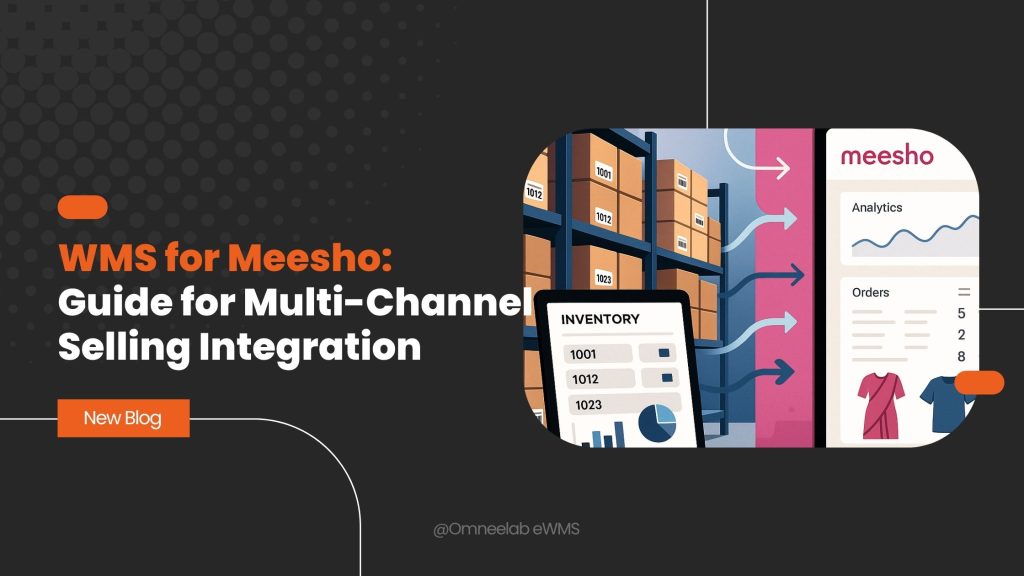
In this comprehensive guide, we’ll explore how to leverage a WMS for Meesho to streamline your operations, automate processes, and scale your business effectively. Whether you’re a seasoned seller or just starting your journey, understanding these integration strategies will transform how you manage your multi-channel selling operations.
Understanding WMS and Its Importance for Meesho Sellers
What is a Warehouse Management System?
A Warehouse Management System (WMS) is your digital command center for inventory operations. Think of it as the brain that coordinates everything from stock tracking to order fulfillment, ensuring your business runs like a well-oiled machine.
For Meesho seller tools, a WMS becomes even more critical because it bridges the gap between your physical inventory and digital sales channels. It’s not just about storing products – it’s about creating an intelligent system that anticipates demand, optimizes storage, and accelerates order processing.
Why Meesho Sellers Need WMS Integration
The Meesho seller panel integration with a robust WMS offers several compelling advantages:
Inventory Accuracy: Manual tracking leads to overselling or stockouts. A WMS provides real-time visibility into your inventory levels across all channels, reducing discrepancies by up to 85% Processing Speed. With Meesho order processing becoming increasingly competitive, automated systems can achieve 75-80% reduction in processing time compared to manual methods Synchronization. Managing inventory across Myntra, Meesho, Amazon, Flipkart, and your own website becomes seamless with centralized control.
Cost Reduction: Automated processes reduce labor costs and minimize errors that can lead to returns and customer dissatisfaction.
Meesho’s Unique Value Proposition
What sets Meesho apart is its zero-commission model and focus on Tier 2 and Tier 3 cities, which account for over 70% of its customer base. This creates unique opportunities for sellers but also presents specific challenges that a well-integrated WMS can address:
- Social Commerce Integration: Managing inventory for Meesho’s reseller network
- Regional Demand Patterns: Handling diverse demand across different Indian states
- Festival Season Scaling: Automated inventory management during peak shopping periods
- Language Localization: Multi-language product catalog management
Key Features of Meesho Seller Panel
Dashboard Overview and Navigation
The Meesho seller dashboard serves as your business control center. Upon completing the Meesho seller login process, you’ll access a comprehensive interface that displays:
- Real-time order status updates
- Inventory levels and alerts
- Payment tracking and Meesho payment cycle information
- Customer interaction history
- Performance analytics and insights
Essential Seller Panel Features
- Product Management: The Meesho catalog upload functionality allows both individual and bulk product listings. You can upload high-quality images, detailed descriptions, and competitive pricing information.
- Order Tracking: Real-time order management helps you monitor shipments and handle customer inquiries efficiently through the integrated system.
- Analytics Tools: Built-in Meesho sales analytics provide insights into customer behavior, sales performance, and market trends.
- Customer Support Integration: Direct access to Meesho seller support ensures quick resolution of issues and smooth operations.
- Social Commerce Tools: Unique features for managing reseller networks and social media integration that differentiate Meesho from traditional e-commerce platforms.
How to Connect WMS with Meesho: Step-by-Step Integration
Pre-Integration Preparation
Before diving into how to connect WMS with Meesho, ensure you have:
- Complete Seller Registration: Follow the Meesho seller registration process with all required documents including GSTIN, PAN card, and bank details.
- API Access: Obtain necessary API credentials from both your WMS provider and Meesho’s developer portal.
- Data Mapping: Identify how your product categories, SKUs, and inventory data will align between systems.
- Compliance Setup: Ensure GST integration and other regulatory requirements are configured.
Integration Process
Step 1: API Configuration
Start by configuring the API connections between your WMS and Meesho supplier panel features. This involves:
- Setting up authentication protocols
- Establishing data synchronization intervals
- Configuring error handling and retry mechanisms
Meesho-Specific API Considerations:

Step 2: Product Catalog Synchronization
Implement Meesho bulk product upload capabilities through your WMS:
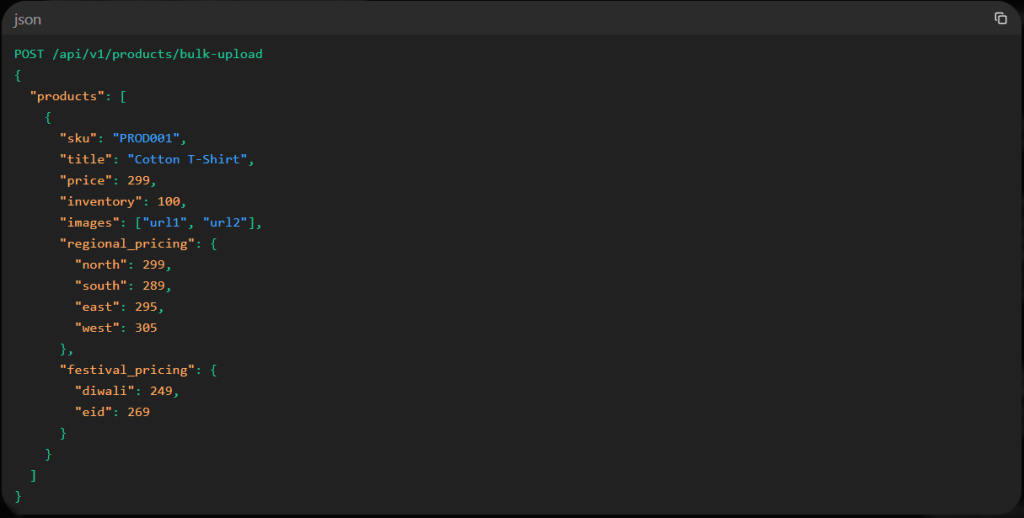
Step 3: Inventory Synchronization
Configure real-time Meesho stock tracking to ensure inventory levels remain accurate across all channels:
- Set up automatic stock updates
- Configure low-stock alerts
- Implement safety stock levels
- Regional inventory allocation for Meesho’s geographic distribution
Step 4: Order Management Integration
Establish seamless Meesho order fulfillment workflows:
- Automatic order import from Meesho to WMS
- Inventory allocation and picking list generation
- Shipping label creation and tracking updates
- COD (Cash on Delivery) handling for Meesho’s customer preferences
Implementation Timeline
- Week 1-2: API setup and testing
- Week 3-4: Product catalog migration and validation
- Week 5-6: Order workflow automation and testing
- Week 7-8: Analytics integration and optimization
Inventory Management Best Practices
Real-Time Stock Synchronization
Meesho inventory management requires constant vigilance. Your WMS should update stock levels across all channels within minutes of any transaction. This prevents overselling and maintains customer trust.
Key Implementation Tips:
- Set up webhook notifications for instant updates
- Implement buffer stock for high-velocity items
- Configure automatic reorder points based on sales velocity
- Regional stock allocation for Meesho’s geographic reach
Multi-Channel Inventory Allocation
Smart inventory allocation ensures you’re maximizing sales opportunities across all platforms while maintaining adequate stock levels:
- Channel Prioritization: Allocate inventory based on channel performance and profitability. Meesho’s zero-commission model often makes it a priority channel for margin optimization.
- Dynamic Allocation: Adjust allocation percentages based on seasonal trends and promotional activities, particularly during Indian festival seasons.
- Safety Stock Management: Maintain appropriate safety stock levels to handle demand fluctuations, especially in Tier 2/3 cities where demand patterns can be unpredictable.
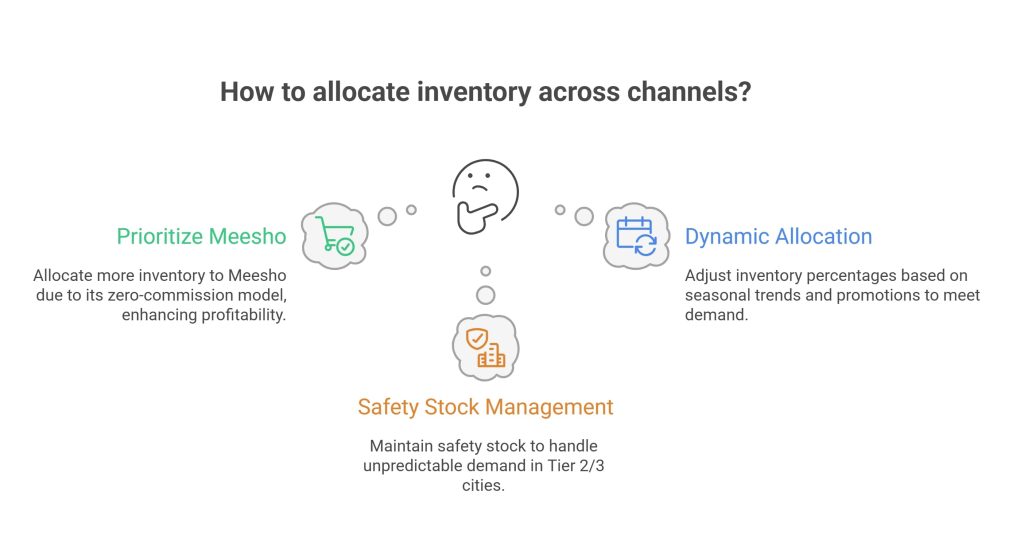
Festival Season Management
Indian e-commerce is heavily influenced by festival seasons. Your WMS integration should include:
- Automated Scaling: Increase inventory levels automatically before major festivals like Diwali, Eid, and regional celebrations.
- Dynamic Pricing: Implement festival-specific pricing strategies through your WMS.
- Regional Customization: Different festivals have varying importance across Indian regions – your system should account for this.
Order Processing Automation
Streamlined Order Workflows
Efficient Meesho order processing automation can dramatically improve your operational efficiency:
- Automatic Order Import: Orders from Meesho flow directly into your WMS without manual intervention.
- Intelligent Routing: Orders are automatically routed to the optimal fulfillment location based on inventory availability and shipping costs.
- Pick List Generation: Automated creation of optimized picking routes reduces fulfillment time by up to 50%
- COD Handling: Special workflows for Cash on Delivery orders, which represent 65% of Meesho transactions Integration with Logistics Partners
Meesho logistics solutions work best when integrated with your WMS:
- Automatic last-mile carrier tracking based on destination and package characteristics
- Real-time tracking updates sent to customers
- Exception handling for delivery issues
- Regional carrier optimization for Tier 2/3 city deliveries
Social Commerce Order Management
Meesho’s unique reseller model requires specialized order handling:
- Reseller Commission Tracking: Automated calculation and tracking of reseller commissions.
- Bulk Order Processing: Handling large orders from successful resellers.
- Social Media Integration: Managing orders that originate from social media shares and referrals.
Product Listing Optimization
Bulk Upload Strategies
Effective Meesho product listing tips start with efficient bulk upload processes:
- Template Optimization: Create standardized templates that include all required fields and SEO-optimized content for Indian market preferences.
- Image Management: Implement automated image processing to ensure consistent quality and formatting that appeals to Meesho’s customer base.
- Category Mapping: Establish clear category hierarchies that align with Meesho’s taxonomy and regional preferences.
- Regional Customization: Adapt product descriptions and pricing for different Indian regions and languages.
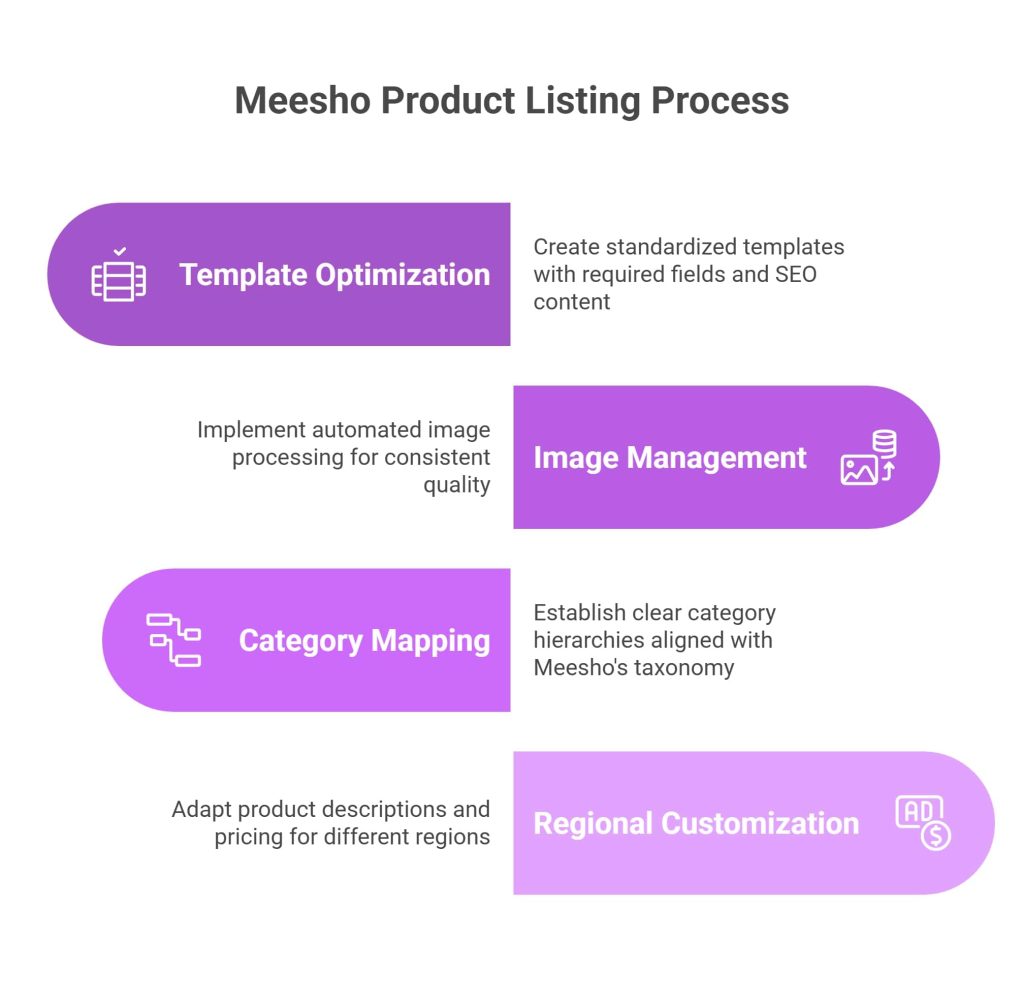
SEO and Visibility Enhancement
- Keyword Integration: Use relevant Hindi and regional language keywords alongside English to improve discoverability.
- High-Quality Images: Multiple product angles and lifestyle images significantly impact conversion rates, especially for fashion and lifestyle products popular on Meesho.
- Competitive Pricing: Implement dynamic pricing strategies based on market conditions and competitor analysis, leveraging Meesho’s price comparison tools.
- Festival Optimization: Seasonal product positioning and pricing for Indian festivals and celebrations.
Advanced Analytics and Performance Tracking
Key Performance Indicators (KPIs)
Monitor these essential metrics through your integrated Meesho sales analytics:
Sales Performance:
- Revenue growth rate across different regions
- Order volume trends during festival seasons
- Average order value by customer segment
- Conversion rates by product category
Operational Efficiency:
- Order processing time benchmarks
- Inventory turnover by region
- Return rates and reasons
- Customer satisfaction scores
Regional Performance:
- State-wise sales analytics
- Tier 2/3 city performance metrics
- Regional customer acquisition costs
- Local competition analysis
Predictive Analytics
- Demand Forecasting: Analyze historical data to predict future demand patterns, especially crucial for festival season planning.
- Regional Trends: Identify emerging markets and customer preferences in different Indian states.
- Inventory Optimization: Use AI-driven insights to optimize buffer stock levels and reduce carrying costs.
- Price Optimization: Dynamic pricing based on regional demand, competition, and seasonal factors.
Data-Driven Decision Making
Use analytics to optimize your Meesho business growth strategy:
- Customer Segmentation: Automated targeting based on Meesho’s customer demographics and purchasing behavior.
- Channel Performance: Compare performance across different sales channels to allocate resources effectively.
- Seasonal Planning: Prepare for festival seasons and regional celebrations with data-backed inventory and marketing strategies.
Automation Benefits and ROI
Operational Efficiency Gains
Meesho e-commerce automation delivers measurable benefits:
- Time Savings: Automated processes can reduce manual work by up to 80%, allowing you to focus on strategic activities like market expansion and customer relationship building.
- Error Reduction: Automated data entry and processing minimize human errors that can lead to customer dissatisfaction and returns.
- Scalability: Handle increased order volumes without proportional increases in staff, crucial for managing Meesho’s rapid growth.
- 24/7 Operations: Automated systems work around the clock, processing orders and updating inventory even during non-business hours.
Financial Impact
- Cost Reduction: Lower operational costs through reduced labor requirements and improved efficiency. Typical savings range from 30-50% in operational costs
- Growth: Better inventory management and faster order processing lead to increased sales and customer satisfaction.
- Improved Cash Flow: Faster order processing and Meesho’s favorable payment terms improve cash flow dynamics.
- ROI Metrics: Most businesses see 200-400% ROI within the first year of WMS implementation Compliance and Regulatory Considerations
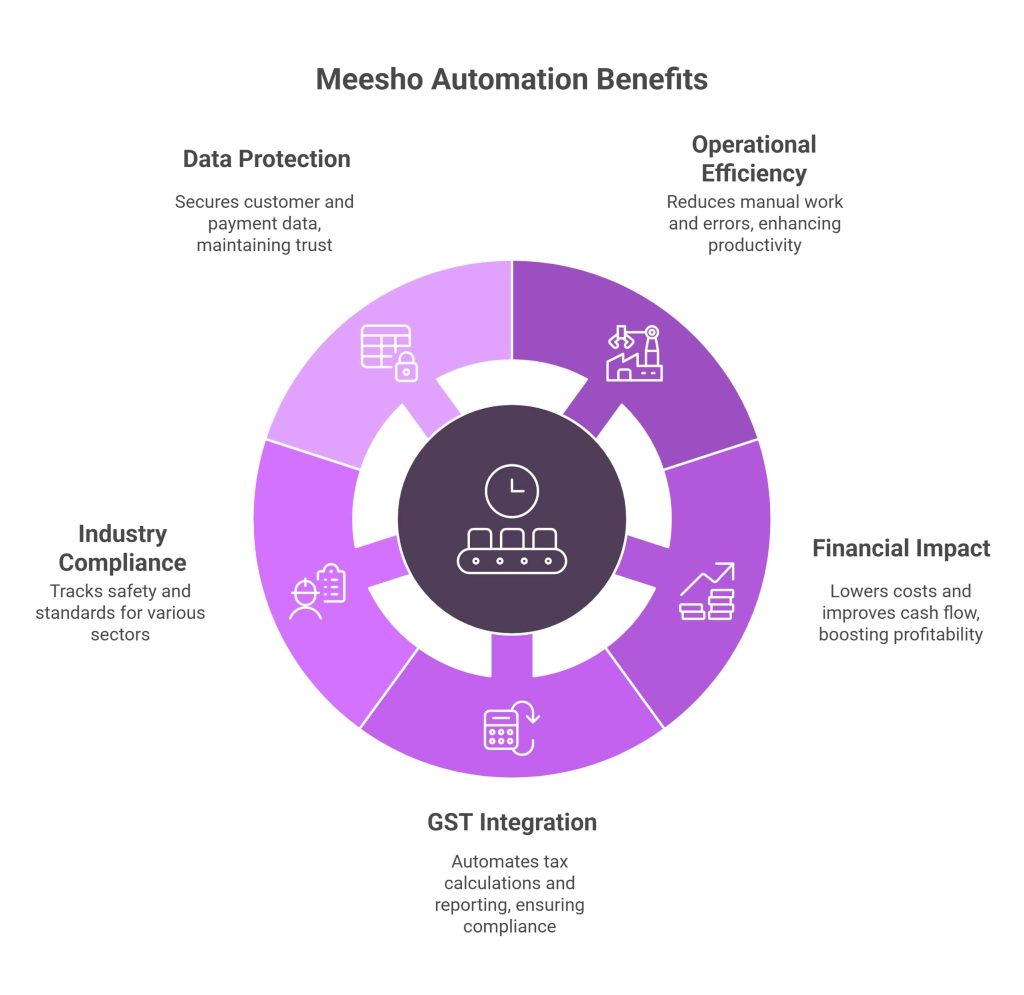
GST Integration
- Automated Tax Calculations: Real-time GST calculations for different Indian states and product categories.
- Compliance Reporting: Automated generation of GST returns and compliance reports.
- Inter-State Transaction Management: Proper handling of IGST for cross-state transactions common in Meesho’s pan-India operations.
Industry-Specific Compliance
- FSSAI Compliance: For food and beverage sellers on Meesho, automated tracking of food safety compliance.
- BIS Standards: Product compliance tracking for electronics and appliances.
- Textile Regulations: Compliance with Indian textile and apparel regulations for fashion sellers.
Data Protection
- Customer Data Security: Ensuring compliance with Indian data protection regulations.
- Payment Security: Secure handling of payment information and COD transactions.
- Regional Compliance: Adherence to state-specific regulations and requirements.
Common Integration Challenges and Solutions
Technical Challenges
- API Limitations: Work with your WMS provider to ensure robust API capabilities that can handle Meesho’s specific requirements and rate limits.
- Data Synchronization Issues: Implement proper error handling and retry mechanisms to maintain data consistency across systems.
- System Compatibility: Ensure your WMS can integrate with Meesho’s evolving platform requirements and new features.
- Regional Connectivity: Account for varying internet connectivity in different Indian regions when designing your integration.
Operational Challenges
- Staff Training: Invest in comprehensive training programs to help your team adapt to new automated processes, particularly important in the Indian context where digital literacy varies.
- Change Management: Implement gradual rollouts to minimize disruption to existing operations.
- Quality Control: Establish checkpoints to ensure automation doesn’t compromise product quality or customer service.
- Cultural Adaptation: Ensure your automated systems can handle regional preferences and cultural nuances important to Meesho’s diverse customer base.
Solutions and Best Practices
- Phased Implementation: Roll out features gradually to minimize disruption and allow for optimization.
- Continuous Monitoring: Implement robust monitoring and alerting systems to quickly identify and resolve issues.
- Backup Processes: Maintain manual backup processes for critical operations during system maintenance or failures.
- Regular Updates: Stay current with Meesho platform updates and adjust your integration accordingly.
Future-Proofing Your Integration
Staying Updated with Platform Changes
Meesho continuously evolves its platform capabilities. Stay informed about:
- New API features and capabilities
- Changes to seller panel functionality
- Updated Meesho marketing tools and promotional opportunities
- Emerging social commerce features
Emerging Technologies
- Voice Commerce Preparation: WMS readiness for Meesho’s potential voice-based ordering features, important for India’s growing voice search adoption.
- AR/VR Integration: Preparing for Meesho’s potential augmented reality product visualization features.
- AI-Powered Recommendations: Integration with AI-driven product recommendation engines.
- Blockchain Tracking: Supply chain transparency for premium product categories and authenticity verification.
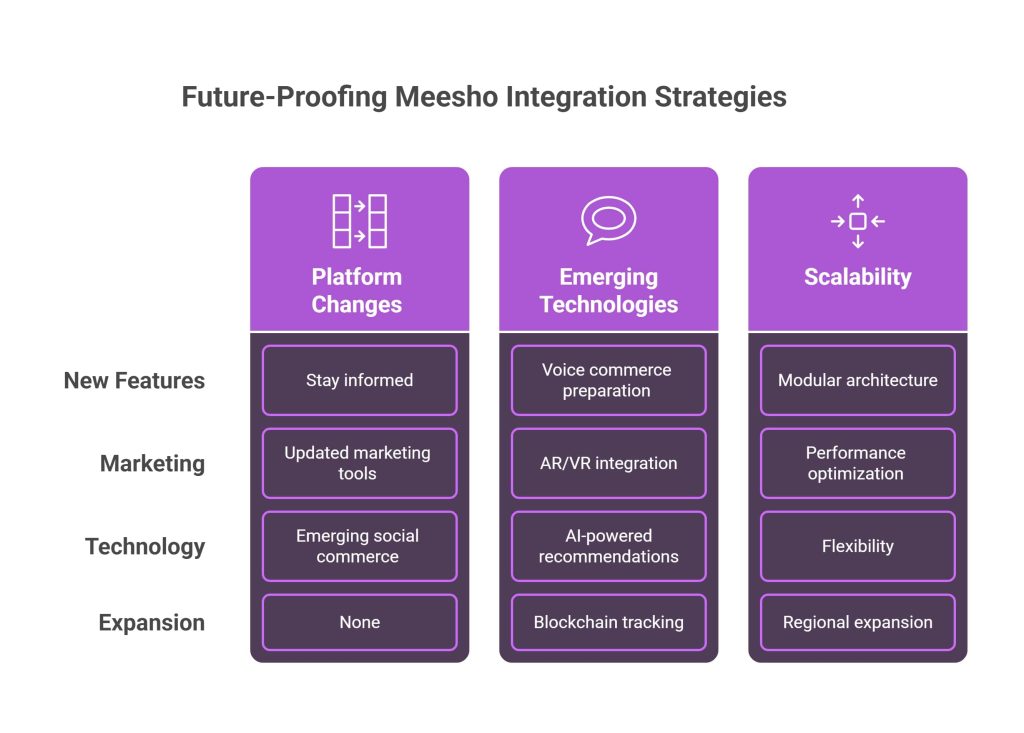
Scalability Considerations
Design your integration with growth in mind:
- Modular Architecture: Build systems that can easily accommodate new features and channels as your business expands.
- Performance Optimization: Ensure your integration can handle increased transaction volumes as you scale.
- Flexibility: Choose solutions that can adapt to changing business requirements and market conditions.
- Regional Expansion: Design systems that can easily accommodate expansion into new Indian states and regions.
Advanced Automation Features
Dynamic Pricing
- Real-Time Price Adjustments: Automated pricing based on Meesho market conditions, competitor pricing, and demand patterns.
- Regional Pricing: Different pricing strategies for different Indian regions based on local purchasing power and competition.
- Festival Pricing: Automated seasonal pricing adjustments for Indian festivals and celebrations.
Smart Reordering
- AI-Driven Inventory Replenishment: Automated reordering based on Meesho sales velocity, seasonal trends, and regional demand patterns.
- Supplier Integration: Direct integration with suppliers for automated purchase order generation.
- Quality Assurance: Automated quality checks and supplier performance monitoring.
Customer Segmentation
- Automated Targeting: Dynamic customer segmentation based on Meesho’s customer demographics and purchasing behavior.
- Personalized Marketing: Automated marketing campaigns tailored to different customer segments.
- Regional Customization: Marketing messages and product recommendations adapted for different Indian regions and languages.
Conclusion
Integrating a WMS for Meesho isn’t just about technology – it’s about transforming your business operations for sustainable growth in India’s rapidly evolving e-commerce landscape. The combination of Meesho’s zero-commission model, extensive reach to Tier 2+ cities, and robust seller tools creates unprecedented opportunities for Indian entrepreneurs.
By implementing the strategies outlined in this guide, you’ll be well-positioned to:
- Streamline your multi-channel selling Meesho operations with 75-80% efficiency gains
- Improve inventory accuracy and reduce stockouts by up to 85%
- Accelerate order processing and customer satisfaction
- Scale your business efficiently across multiple platforms
- Leverage India-specific opportunities like festival seasons and regional preferences
The key to success lies in choosing the right WMS solution, implementing it thoughtfully with proper change management, and continuously optimizing your processes based on performance data and market feedback.
Success Metrics to Track:
- Order processing time reduction
- Inventory accuracy improvements
- Customer satisfaction scores
- Revenue growth across channels
- Operational cost savings
Ready to transform your Meesho selling experience? Start by evaluating your current operations, identifying integration opportunities, and selecting a WMS provider that understands the unique requirements of Indian e-commerce.
For businesses seeking a comprehensive solution, OmneelabWMS offers AI-powered warehouse management specifically designed to bridge inventory through technology, supporting B2B, B2C, and D2C fulfillment with over 6+ years of industry expertise.
The future of multi-channel selling is automated, efficient, and profitable – and it starts with the right technology foundation tailored for the Indian market. Consider partnering with WMS providers who have proven experience with Indian e-commerce platforms and understand the nuances of selling to India’s diverse customer base. The investment in proper integration will pay dividends as your business scales and adapts to the evolving e-commerce landscape.
Frequently Asked Questions (FAQs)
To integrate your WMS with Meesho, you’ll need to complete the Meesho seller registration process first, obtain API credentials from both systems, configure data mapping between your inventory and Meesho’s product catalog, and set up real-time synchronization for inventory, orders, and product information. The process typically involves API configuration, product catalog synchronization, and automated order management workflows. Most integrations can be completed within 6-8 weeks with proper planning.
A WMS for Meesho sellers provides real-time inventory tracking across multiple channels, automated order processing with 75-80% efficiency gains, reduced manual errors, improved operational efficiency, better demand forecasting, streamlined product listing management, and enhanced customer satisfaction through faster fulfillment. It also helps leverage Meesho’s zero commission model more effectively by reducing operational costs and enabling better regional market penetration.
Multi-channel inventory management on Meesho requires implementing real-time stock synchronization, setting up automatic allocation rules, configuring safety stock levels, using centralized inventory tracking, establishing reorder points, and implementing dynamic pricing strategies. A properly integrated WMS ensures inventory accuracy across all sales channels while preventing overselling and optimizing for regional demand patterns specific to Indian markets.
The Meesho seller panel is a comprehensive dashboard that allows sellers to manage their entire e-commerce operations including product listings, order tracking, inventory management, payment processing, customer interactions, and performance analytics. Sellers access it through the Meesho seller login process and can manage both individual and bulk product uploads, track the payment cycle, utilize social commerce features, and access various seller tools for business growth in India’s diverse market.
Bulk product upload on Meesho involves accessing the “Catalogs Upload” section in your seller dashboard, downloading the appropriate category template, filling in product details including titles, descriptions, prices, and images, ensuring all mandatory fields are completed, and submitting the catalog for review. The process supports multiple product categories and allows for efficient scaling of your product listings through automated WMS integration, with support for regional pricing and festival-specific configurations.
People also read:
- Common Inventory Management Challenges
- WMS for Magento
- WMS for WooCommerce
- Last Mile Delivery Stations in India
- WMS for Last Mile in India
- Small Business Barcoding
- Demand-driven Replenishment Practices for Retailers
- Guide to Managing Perishable Inventory
- What Is a Bill of Materials (BOM)? Expert Guide & Tips
- Inventory Management with Barcode Technology

Kapil Pathak is a Senior Digital Marketing Executive with over four years of experience specializing in the logistics and supply chain industry. His expertise spans digital strategy, search engine optimization (SEO), search engine marketing (SEM), and multi-channel campaign management. He has a proven track record of developing initiatives that increase brand visibility, generate qualified leads, and drive growth for D2C & B2B technology companies.